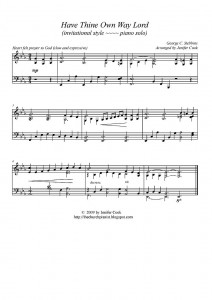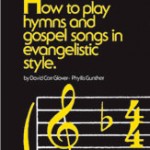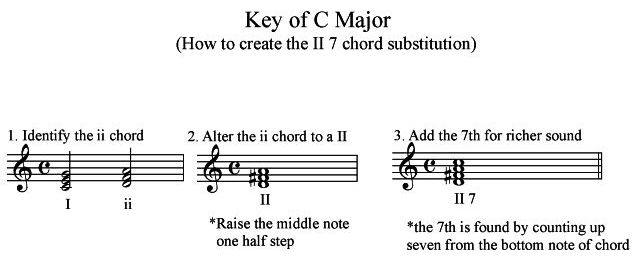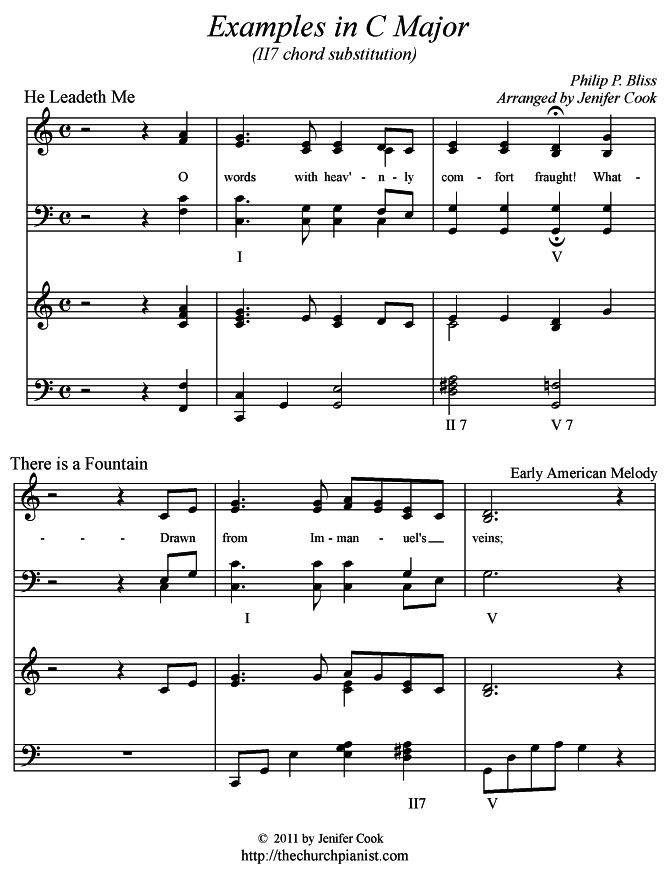Archive for the ‘Improvising hymns’ Category
When the Roll is Called Up Yonder (part of chorus) Advanced version
The Church Pianist: Improvising Tip
Wednesday, November 9th, 2011 ![]() Over the past ten years, I’ve learned ALOT of theory amidst many hours of composing hymn arrangements. There’s so much more I need to learn but I just pick up tips here and there and put them to use. Now…I’ll share one of those tips with you.
Over the past ten years, I’ve learned ALOT of theory amidst many hours of composing hymn arrangements. There’s so much more I need to learn but I just pick up tips here and there and put them to use. Now…I’ll share one of those tips with you.
The following improvising tip has made a difference in my hymnplaying; creating a more open, balanced sound. I apply this tip to my congregational and solo playing.
The following hymn example contains “Come Thou Fount” in D major and the improvising tip.
Click here to download “Come Thou Fount” with improvising tip.
Just for fun: After playing the above improvised example…add the 3rd of the chord in the right hand too…just to hear the difference.
Congregational Singing Tip for Church Pianists
Sunday, October 16th, 2011Since believing on Jesus Christ at the age of 29…I can truly say: “Blessed Assurance Jesus is Mine”. This became one of my favorite hymns after becoming a Christian.
Shortly after being saved I arranged an offertory that included: “Blessed Assurance, Saved by the Blood and Since Jesus Came Into My Heart”. I will have to write it out in my (ha ha) spare time.
This free sacred piano arrangement of “Blessed Assurance” is a result of preparing several of our own soon-to-be church pianists to play for congregational singing. We now have a rotational schedule for our intermediate to advanced pianists to allow them to play for our congregational singing. It’s exciting to see them gain experience to better equip them for serving the Lord.
Click here for the free sacred piano arrangment of “Blessed Assurance” page one.
I’ll share the rest of this free arrangement in the next article.
How to Play Hymns & Gospel Songs in an Evangelistic Style
Tuesday, October 11th, 2011Just discovered a practical instructional book on improvising hymns found on Alfred Publishing’s site.
This book is a great starter for the intermediate pianist who wants to improvise from the church hymnal. The pianist will learn how to do the following:
*Add tenor to the right hand
*Double the bass note
*A couple of easy-to-learn left hand fill-in ideas
*PLUS…a collection of hymns already arranged for the intermediate church pianist using the improvising ideas that are taught in the book.
Click on the following book title to view the book and sample pages!
Improvising Hymns: Lesson Two
Sunday, October 9th, 2011Click here to download worksheet before watching video for “Improvising Hymns” Lesson Two
Have a pencil handy!
The following short video tutorial on improvising hymns is geared to the beginning church pianist. Playing straight from the church hymnal can sound rather plain. Learning how to dress up the hymns adds a new dimension of sound! This lesson gives some simple left hand fill in ideas for the first line of “When I Survey the Wondrous Cross”.
Special clarification about the theory rule mentioned in this lesson concerning omitting the 3rd of the chord…The 3rd can be omitted from either hand. Wait until you see the video below to understand this explanation 🙂
The next video tutorial will reveal more improvising ideas for “When I Survey the Wondrous Cross”.
Click here to see My First Improvising Lesson
Free Improvising Ideas: Count Your Blessings (congregational style)
Sunday, October 2nd, 2011The hymn “Count Your Blessings” carries a great message in song but contains frequent repetitive notes providing a rather plain accompaniment for the average church pianist
Free Improvising Ideas for Count Your Blessings (congregational style)
Key of D Major
1. Use alternate bass movement (see measure #2) LH beat one…I played an ‘A’ rather than ‘D’
2. Measure #1 and #5, beat one ( no need to play every word) when playing congregational style; allows more ease of movement for the pianist.
3. The four note RH chords provide support to the singers.
4. Measure #6, notice the contrary octave movement between the hands for variety.
*Contrary movement between both hands always adds a nice touch of spice 🙂
Click here to download Free Improvising Ideas for Count Your Blessings (congregational style)
Free Piano Arrangement: All Hail the Power (page two)
Sunday, September 18th, 2011I was able to finish page two of “All Hail the Power” tonight even after a busy but good week of revival at our church. I will try to share some music highlights of our week sometime soon.
In my next article…I ‘ll share editor notes along with an audio of this free piano arrangement for “All Hail the Power” congregational accompaniment.
Click here to download “All Hail the Power” congregational accompaniment
Free Piano Arrangement: All Hail the Power (page one)
Sunday, September 11th, 2011I enjoy playing and singing “All Hail the Power”. The church pianist must add lots of fullness to this majestic hymn to portray the mood of the text.
Just picture it…God is on His throne and scores of angels are bowed down before Him. A huge choir is singing “All hail the power of Jesus’ name! Let angels prostrate fall…”
I think the words as I play this wonderful hymn. The melody and text are a great match!
Ingredients for Majestic Hymns
Lots of left hand octaves for fullness and energy
Full chords in right hand
Occasional dotted rhythm…adding extra zest!
Click here to download “All Hail the Power” congregational accompaniment
Lesson One: The II 7 Chord Substitution
Wednesday, August 17th, 2011A reader writes…
I’ve printed your “Have Thine Own Way, Lord”. How did you know to put a F7 on the 2nd “own” in the first full measure…. Is there a process of knowing what chords are to be uses as substitution and when to use them? ~Elise~Fortunately…yes! 🙂 There’s an endless supply of chord substitutions that can be used…depending on the initial chord scenario.
To begin with, I’ll apply this II 7 chord substitution to the key of C Major for easier application. (Otherwise, it’s like teaching a beginner to play Moonlight Sonata at his first lesson)
So…what’s a II chord?! In simple terms…it’s an altered chord. Normally, the second chord in any major key is a minor chord…thus marked in lowercase roman numerals…ii. For example, in the key of C Major…the ii chord is D-F-A. (D is the second note in the key of C Major which gives the chord its number). But…we can alter the chord (making it a major chord) by raising the middle note of the chord (the note F to an F sharp). * See example below
Now…to create the II 7 chord…just add the 7th note above the bottom note of the chord. *See Example below
Chord Scenario for the II 7 Chord Substitution:
1. When a I chord lasts for at least two or more beats leading into a V or V 7 chord lasting two or more beats. (to allow time for chords to develop) I’ve used the II 7 chord with less beats but in general…it’s best to allow enough beats for chords to sound like they belong and not just randomly thrown in.
In the examples below, I’ve included the vocal and piano score to reflect the changes made in the piano accompaniment. *Reminder: chord substitutions clash with congregational singing due to the note changes.
I use chord substitutions when playing solo offertories, background music for invitation, prelude/postlude, communion and accompanying a vocal or instrumental soloist.
~ ~ ~ ~ ~ ~ ~ ~ ~ ~ ~ ~ ~ ~ ~ ~ ~ ~ ~ ~ ~
In Lesson Two, I’ll share more examples of this II7 chord substitution… including “Have Thine Own Way”.
*Please feel free to ask questions.
Upcoming Article: Substituting the I Chord with the II7 Chord
Tuesday, August 16th, 2011 A reader recently asked me how I knew to use a certain chord substitution in one of my free arrangements “Have Thine Own Way”.
A reader recently asked me how I knew to use a certain chord substitution in one of my free arrangements “Have Thine Own Way”.
My first answer would be…I just thought it sounded nice. But…unfortunately that’s NOT the best answer. I hope to explain it in such a way that the average church pianist can take and apply this chord substitution on their own.
Looking forward to posting this article soon!




